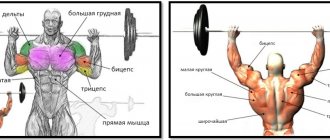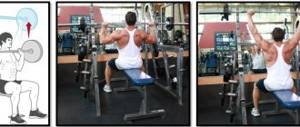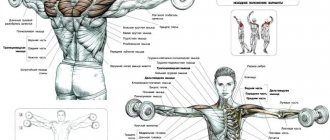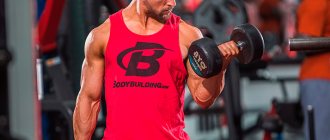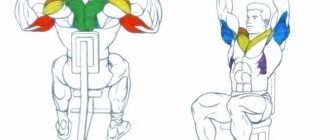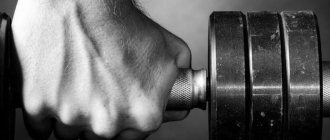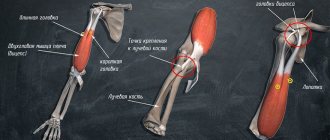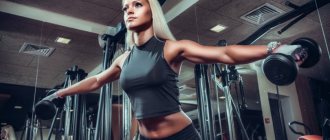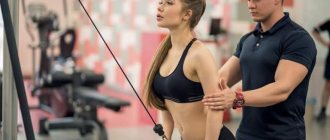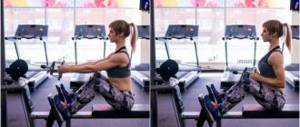The essence of the exercise
The standing dumbbell press is a complex exercise for the upper body. At the same time, its main task is to work the deltas and triceps. When performed correctly, the pectoral muscles are also involved. In any case, it is useful at all stages of preparation, because:
- Allows you to increase your bench press performance (by increasing triceps strength).
- It is an excellent replacement for swings that are complex in technique.
- It is one of the best exercises for the upper shoulder girdle.
In addition, we must not forget that this is the only exercise that develops the upper shoulder girdle as a whole. Neither push-ups nor presses, even on an incline bench, will develop shoulder width as much as a standing dumbbell press does.
Note: a complex exercise is multi-joint but does not belong to the basic ones due to the size of the muscles being worked and the lack of full load on the entire target group.
How to do a standing dumbbell press correctly
In continuation of the series of articles on pumping up the shoulders, on the agenda is a rather specific exercise for the development of the shoulder girdle and deltoids - the standing dumbbell press. It is considered to be basic, since more than one joint is involved in the execution process. The emphasis is on working the anterior deltoid.
You all know that the shoulder is divided into 3 parts: the front, back and middle beam. When performing “pushing” exercises
– the load falls precisely on
the front delta
.
When the mechanics of movement is pulling the projectile towards you
the rear delta
comes into play .
Swing movements
in any variations to the sides load
the middle part of the shoulder
.
Muscle atlas
In different variations, the standing military dumbbell press can engage a huge number of small muscle groups.
| Muscle group | Load | Types of exercises |
| Extensor arm triceps | Significant accent | Standing Dumbbell Press, Military Press, Shung Press, Standing Arnold Press |
| Lateral head of triceps | Slight emphasis | Standing dumbbell press, military press |
| Wrist muscles | Static loading | Standing Dumbbell Press, Military Press, Shung Press, Standing Arnold Press |
| Upper delta | Dynamic basis | Standing Dumbbell Press, Military Press, Shung Press |
| Anterior delta | Slight emphasis | Arnold Press |
| Collar | Basic load | Arnold Press |
| Upper bundle of pectoral muscles | Slight emphasis | Army press |
| Muscles of the lumbar region | Stabilizing load | Standing Dumbbell Press, Military Press, Shung Press, Standing Arnold Press |
| Thigh muscles | Blasting load | Shung press |
| Quadriceps | Blasting load | Shung press |
In its basic variation, this exercise primarily involves:
- Upper deltas.
- Triceps.
- Lumbar region.
As can be seen from the muscle atlas, this exercise is multi-joint, but its load is not enough to generally shock the body and increase the level of anabolism. That is why it is included in split programs, and not added to the classic “press-dead-squat” trio. At the same time, if we are talking about functional lifting strength and impact force, then a better exercise than the dumbbell upward press has not yet been invented.
Errors
- » Do not lower the projectile quickly
. It is necessary to provide resistance to the dumbbells, the so-called negative phase of the movement, due to which our muscles hypertrophy and growth occurs. - "Jerks and thrusts.
There is no need to sharply push or tear from place, or jump. You need to press under control, focus on the technique and feeling of the muscle itself, and not push the dumbbells up with inertia. - » Don't lift heavy weights.
There is no need to surprise everyone in the room, we already know that you are a strong man. If you select the wrong weight, you will ruin the workout, the load, you will lose your balance, you may get injured, and you will strain all muscle groups except the shoulders.
Number of approaches and repetitions
- »
For men: 8 - 10 reps 4 sets. - »
For women: 8 - 12 repetitions 2-3 sets.
How can you replace the standing dumbbell press?
If everything is bad with coordination, then the sitting dumbbell press will be similar in movement dynamics and loads and the standing barbell press will be less similar.
Variations of the exercise
The standing dumbbell press is an exercise that dates back to the golden era of bodybuilding. In an effort to expand the load and shock muscle groups, various variations have been created, which are divided into three main types:
- With a change in the trajectory of movement.
- Using cheating.
- With perfectly clean equipment.
Despite this, in gyms it is recommended to use only subtypes of exercise with pure technique for the reason that they:
- Able to work deeper on target muscle groups.
- They are less traumatic for the athlete.
- Allows you to control the result.
Classic military press
The classic military press differs from the simple one in the position of the hands at the start of the exercise. They are fixed slightly forward in relation to the position of the standardized press. All this allows you to take on heavier weights, which means loading your deltoids more heavily.
The technique is made easier by lowering the dumbbells below shoulder level, but it increases the overall injury rate, since the load on the joint increases significantly. However, for athletes who have stagnant growth in their deltoids and triceps, the military press will allow you to expand the range of motion, and therefore engage deep muscle groups that are usually not involved until the last repetition.
Arnold press
The Arnold Press was not originally intended to be a standing press, but his technique of lifting dumbbells upward allows you to concentrate the load on the upper part of the pectoral muscles.
Its technique is in many ways similar to the military press, the main difference being the supination and rotation of the hands. Thus, the arms are never at the transition point of amplitude; turning the hands changes the trajectory of movement in the shoulder joint, which places the load on the “collar muscles of the chest,” which lag behind even many modern bodybuilders.
Shung press
The push press is the most difficult but at the same time the most effective exercise for developing deltoids and triceps. It develops:
- Explosive power of the upper deltas.
- Deep muscles of the shoulder joints.
- Muscles of the legs and back.
The main difference from the classic bench press is that the dumbbells are not lifted, but pushed above your head. In order to make the technique safer, instead of rotations, a neutral grip is used (palms facing each other).
Due to this, the main movement comes from the back and is transmitted to the deltas. As a result, at the lower part of the amplitude, the load on the triceps is reduced, but it is a powerful stabilizer in the upper amplitude of movement, where the impulse from the back is almost completely absorbed by suppressing the inertia of the weight.
Sequence of the exercise
- Stand up straight, hold a dumbbell in both hands
- Place the dumbbells over your shoulders and take a deep breath.
- Start pressing the dumbbells up, keeping your body perpendicular, head looking forward, exhale
- At the top point of the amplitude there is no need to delay, we smoothly lower down and press up a little faster
Technique
Note: the editors will not consider an alternative exercise technique to the classic dumbbell lift, due to the fact that it is intended for more advanced athletes and has a greater risk of injury. For those who want to master the Arnold press or shvungs, we recommend visiting the relevant articles.
The classic standing press technique involves working with light weights.
- To begin, take dumbbells with an overhand grip.
- Place both dumbbells on your shoulders so that your elbow and shoulder joints are 90 degrees apart.
- Slowly, fixing the movement exclusively with the elbow joint, raise the dumbbells above your head.
There are several factors to pay attention to:
- When working with heavy weights, it is better to use a weightlifting belt, since if the technique is violated, a torque of the spine occurs with a large static load on the lumbar muscles.
- It is NOT recommended to extend your arms until the joint clicks (i.e. completely). It is better not to slightly bring the movement to the top point, this will allow you to develop more strength and reduce the resulting load on the elbows.
- It is important to carefully monitor your movements, so the exercise is traditionally performed in front of a mirror. Any deviation from the standard amplitude has a strong impact on the shoulder joint, which leads to its “grinding”.
- This exercise is done with full inhalation and exhalation.
Execution technique
The standing dumbbell press is similar in technique to the barbell press from the chest and the barbell press from behind the head. But there are also differences, such as the amplitude of movement, which is much greater here. When you press from behind your head, the bar stops very high at the lowest point; the discomfort caused in the shoulder joints does not allow you to go lower, as they begin to be in an unnatural position.
When you press the barbell from the chest, the bar drops almost to the very top of the pecs, this is already more than in the previous exercise, but not as much as it is realized in the standing barbell press. When performing this exercise, the dumbbells are lowered very low and travel through a greater amplitude, thus contracting more muscles.
The standing dumbbell press is considered a safer exercise.
and less traumatic due to freedom of movement and large amplitude. We are not tied to any static trajectory of movement, the joints are very comfortable, and even if it is inconvenient to pass the amplitude at any point of the trajectory with dumbbells, we can slightly turn them around, twist them, that is, change the trajectory for comfort and safety.
Third huge plus
– the volume of the exercise thanks to the stabilizers involved in the work. We don’t have hyphae or static, we need to maintain balance and control both hands, this is where stabilizers come into play.
More on the shoulders:
Arnold delt press
On to the cons
We can attribute the small amount and weight that can be taken in the exercise in comparison with the standing barbell press. After all, it takes more effort to lift dumbbells, you need to control their balance. That is, if your working bench press is 80 kg, then you will not be able to perform the same repetitions and as many repetitions with two 40 kg dumbbells.
Body position. In no case do we lean back to assist in the pushing movement and keep the body vertically upward.
Head position. When pressing dumbbells, the head only looks straight ahead. There is no need to lift it up and accompany the projectiles.
Elbow position. Try to keep your elbows parallel to the body in the same plane throughout the entire range of movement. Do not bring them forward and press from the chest (like an Arnold press)
Which dumbbell shoulder press is better standing or sitting?
This question is asked in particular by beginners who come to the gym, we answer: the standing press is a more advanced version of the exercise, it is technically more difficult (balance, control, no support, no bench), you cannot take a lot of weight in it and is suitable for athletes who have trained in the hall for a certain time.
The advantage of the dumbbell press while sitting before standing is that the body is in a fixed position, there is support, it is easier to perform the exercise, you can take more weight, you can rest your feet comfortably on the floor and control your balance - it is more suitable for beginners and slightly advanced athletes. As for the mechanics of movement, everything is identical with the exception of a large number of muscles involved in the standing press (stabilizers)
Replacement for the military press
Due to the fact that many people underestimate the complexity of this exercise, fitness instructors in gyms replace it with simpler and more isolated swings. However, despite the fact that the swing has a significantly lower percentage of injuries compared to the bench press, it is also less effective.
If in the standing dumbbell press a violation of the technique leads to injury, then in the swing it simply reduces the effectiveness of the exercise to zero. Typically, the classic bench press is replaced with three exercises:
- Swing the dumbbells forward.
- Swing the dumbbells up.
- Bent over dumbbell swings.
There is a myth that this is the only way to work out all three delta bundles. This is not entirely true. Under standard work conditions without the use of steroids and the desire to obtain an ideal form, the rear delts are perfectly worked with rows, the front delts with the bench press, and the upper delts with the standing press.
But, if the deltoids really lag behind, then you can also add bent over swings or lateral swings to the standard dumbbell overhead press.
Purpose of the exercise and working muscles
When performed correctly, the standing dumbbell press works the deltoid, supraspinatus, serratus, and trapezius muscles. Stabilization in movement and “pressure” occur due to the triceps brachii muscle.
The goal, however, is to work the shoulders, not the triceps, so the weights are chosen lighter to ensure full mobility in the joints. An additional goal is to eliminate body asymmetry and uniform development of both “halves” of the body, eliminating the natural imbalance in the strength of pressing movements.
Bottom line
Today, the standing overhead dumbbell press is used as an isolation exercise, after pre-exhaustion with basic pressing exercises, be it:
- Bench press on a horizontal bench.
- Incline dumbbell press.
- Close grip press.
After preliminary fatigue of the pectoral muscles, you can create additional stress on the deltoid muscle group and increase triceps performance. However, many athletes perform this exercise exclusively in a 3-day split along with swing exercises and abdominal work.
Thus, it is possible to develop large deltoids and huge arms, while compensating for the shortcomings of basic exercises with a complex of auxiliary swings.
